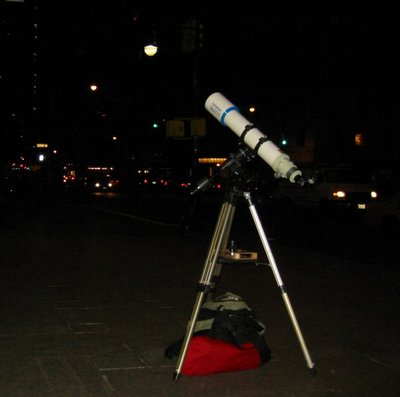20051026 - Observing Mars
Session Name: 20051026.2145
Location: 59th & 6th, Entrance to Central Park, NYC
Site Classification: Urban
Date/time: 26 Oct. 2005, 9:45pm ~ 12:25am
Takahashi FS102, F/8 102mm refractor
Eyepieces
EP :: AFOV :: MAG :: TFOV
Plossl 32mm :: 50° :: 26x :: 2.0°
Nagler 13mm :: 82° :: 63x :: 1.3°
Nagler 9mm :: 82° :: 91x :: 0.9°
Nagler 5mm :: 82° :: 164x :: 0.5°
Accessories: Barlow 2x, Barlow 3x
NELM –
Perseus - m5.24, HIP 14043; m5.04, HIP15219; m4.99, 4 stars (trapezoid) between Mirfak and delta Per.
Hyades 12 stars - 75 Tau (HIP20877) m4.96.
Cas - upsilon^1 m4.83
Conditions: Mars in a clear, moonless sky. Seeing was poor as judged by boiling on Martian surface and limb; transparency was very good. Weather history for 26 Oct. 2005 at wunderground.com
Brought the Tak refractor back out to the sidewalk nearby the statue, Jose de San Martin. Kin biked by shortly after I set up, shouting from his bike as he rode by. Kin would later come back and stay a while. Less than a dozen persons observed Mars through the scope. Almost all of them spoke of NYC bright skies so I pointed out the Pleiades nearby as an example that some things can be seen. At times, I would see Kin speaking with the curious pedestrians and pointing in the sky towards Mars.
The seeing was not nearly as good as the transparency. At times, it was like looking at Mars through running water. The atmosphere would settle, allowing for some good views. I have been looking at the same features on these last 3 sessions. I suspect the major features observed include Syrtis Major, Iapygia, Mare Tyrrhenum, and Mare Cimmerium. I have yet to clearly see and identify Hellas. Last night, the conspicuous dark markings appeared like a "y" leaning to the left in the fov. As a "y", Syrtis Major is the upper right stroke of the character.

The 4" refractor provides some nice views, but I am challenged with getting enough contrast from the image. I am thinking that the 10" is necessary if I expect to get more information from what I see. I have pushed the 4" to 328x (Nagler 5mm & B2x), but that was too soft. I could still see the darkened belts traversing the surface but the lower contrast "continents" did come through satisfactorily. I did most of my observing, and showing the public, with the Barlow 2x and the Nagler 9mm for 182x magnification. Occasionally, I swapped to the Nagler 5mm for a clearer image, however there was little change. I felt the decrease in magnification was too much of a cost so would return to the higher magnification.
<< Home